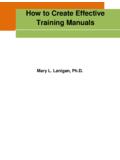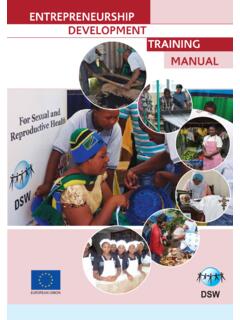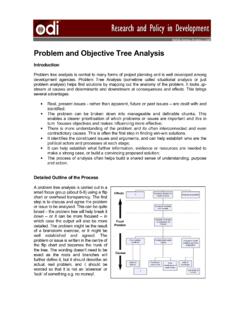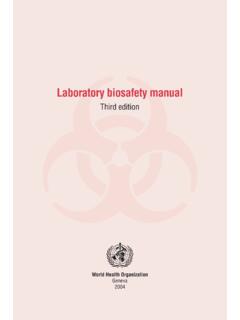Transcription of Chapter 4 Maintaining Aircraft Control: Upset Prevention ...
1 4-1 IntroductionA pilot s fundamental responsibility is to prevent a loss of control (LOC). Loss of control in-flight (LOC-I) is the leading cause of fatal general aviation accidents in the and commercial aviation worldwide. LOC-I is defined as a significant deviation of an Aircraft from the intended flightpath and it often results from an airplane Upset . Maneuvering is the most common phase of flight for general aviation LOC-I accidents to occur; however, LOC-I accidents occur in all phases of flight. To prevent LOC-I accidents, it is important for pilots to recognize and maintain a heightened awareness of situations that increase the risk of loss of control.
2 Those situations include: uncoordinated flight, equipment malfunctions, pilot complacency, distraction, turbulence, and poor risk management like attempting to fly in instrument meteorological conditions (IMC) when the pilot is not qualified or proficient. Sadly, there are also LOC-I accidents resulting from intentional disregard or recklessness. Maintaining Aircraft Control: Upset Prevention and Recovery TrainingChapter 44-2 Figure 4-1. Coordinated flight in a factor 2 G sCentrifugal force G sGravity 1G60 2 PITCHINFORMATIONTo maintain Aircraft control when faced with these or other contributing factors, the pilot must be aware of situations where LOC-I can occur, recognize when an airplane is approaching a stall, has stalled, or is in an Upset condition, and understand and execute the correct procedures to recover the Aircraft .
3 Defining an Airplane UpsetThe term Upset was formally introduced by an industry work group in 2004 in the Pilot Guide to Airplane Upset Recovery, which is one part of the Airplane Upset Recovery training Aid. The working group was primarily focused on large transport airplanes and sought to come up with one term to describe an unusual attitude or loss of control, for example, and to generally describe specific parameters as part of its definition. Consistent with the Guide, the FAA has defined an Upset as an event that unintentionally exceeds the parameters normally experienced in flight or training .
4 These parameters are: Pitch attitude greater than 25 , nose up Pitch attitude greater than 10 , nose down Bank angle greater than 45 Within the above parameters, but flying at airspeeds inappropriate for the conditions. The reference to inappropriate airspeeds describes a number of undesired Aircraft states, including stalls. However, stalls are directly related to angle of attack (AOA), not develop the crucial skills to prevent LOC-I, a pilot must receive Upset Prevention and recovery training (UPRT), which should include: slow flight, stalls, spins, and unusual training has placed more focus on Prevention understanding what can lead to an Upset so a pilot does not find himself or herself in such a situation.
5 If an Upset does occur, however, Upset training also reinforces proper recovery techniques. A more detailed discussion of UPRT to include its core concepts, what the training should include, and what airplanes or kinds of simulation can be used for the training can be found later in this FlightCoordinated flight occurs whenever the pilot is proactively correcting for yaw effects associated with power (engine/propeller effects), aileron inputs, how an airplane reacts when turning, and airplane rigging. The airplane is in coordinated flight when the airplane s nose is yawed directly into the relative wind and the ball is centered in the slip/skid indicator.
6 [Figure 4-1]A pilot should develop a sensitivity to side loads that indicate the nose is not yawed into the relative wind, and the airplane is not slipping or skidding. A correction should be made by applying rudder pressure on the side toward which one feels a leaning sensation. This will be the same side to which the ball in the slip/skid indicator has slewed ( , the old saying step on the ball ). Angle of AttackThe angle of attack (AOA) is the angle at which the chord of the wing meets the relative wind. The chord is a straight line from the leading edge to the trailing edge. At low angles of attack, the airflow over the top of the wing flows smoothly and produces lift with a relatively small amount of drag.
7 As the AOA increases, lift as well as drag increases; however, above a wing s critical AOA, the flow of air separates from the upper surface and backfills, burbles and eddies, which reduces lift and increases drag. This condition is a stall, which can lead to loss of control if the AOA is not reduced. It is important for the pilot to understand that a stall is the result of exceeding the critical AOA, not of insufficient airspeed. The term stalling speed can be misleading, as this speed is often discussed when assuming 1G flight at a particular weight and configuration. Increased load factor directly affects stall speed (as well as do other factors such as gross weight, center of gravity, and flap setting).
8 Therefore, it is possible to stall the wing at any airspeed, at any flight attitude, and at any power setting. For example, if a pilot maintains airspeed and rolls into a coordinated, level 60 banked turn, the load factor is 2Gs, and the airplane will stall at a speed that is 40 percent higher than the straight-and-level stall speed. In that 2G level turn, the pilot has to increase AOA to increase the lift required to maintain altitude. At this condition, the pilot is closer to the critical AOA than during level flight and 4-3 Figure 4-2. Angle-of-attack in of liftCLMAXC oefficient of dragLift to drag of drag (CD)Lift/dragAngle of attack in degreesSeparation& stall0 2 4 6 8 10 12 14 16 18 20 22 closer to the higher speed that the airplane will stall at.
9 Because stalling speed is not a constant number, pilots must understand the underlying factors that affect it in order to maintain Aircraft control in all circumstances. Slow FlightSlow flight is when the airplane AOA is just under the AOA which will cause an aerodynamic buffet or a warning from a stall warning device if equipped with one. A small increase in AOA may result in an impending stall, which increases the risk of an actual stall. In most normal flight operations the airplane would not be flown close to the stall-warning AOA or critical AOA, but because the airplane is flown at higher AOAs, and thus reduced speeds in the takeoff/departure and approach/landing phases of flight, learning to fly at reduced airspeeds is essential.
10 In these phases of flight, the airplane s close proximity to the ground would make loss of control catastrophic; therefore, the pilot must be proficient in slow flight. The objective of maneuvering in slow flight is to understand the flight characteristics and how the airplane s flight controls feel near its aerodynamic buffet or stall-warning. It also helps to develop the pilot s recognition of how the airplane feels, sounds, and looks when a stall is impending. These characteristics include, degraded response to control inputs and difficulty Maintaining altitude.
















